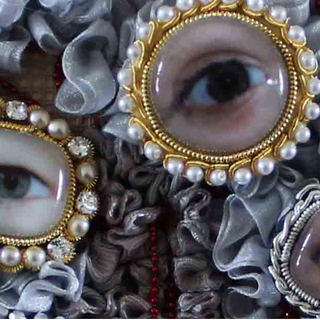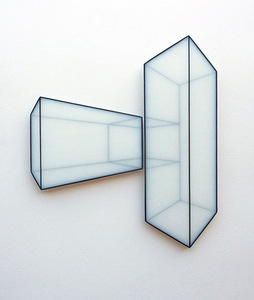Artist Lectures #3 - Victoria Scholes & Karlyn Sutherland
- Daniel Rollitt

- Feb 15, 2017
- 5 min read
Victoria Scholes talked about how she came to work as an artists a little later in life after first being a Church of England priest and working in pharmacy. She started off producing kilnformed domestic objects in glass such as dustpan and brush sets. These changed gradually over time as she used different techniques such as flame working for the bristles and engraving floral patterns to the pans, along with using a combination of wood and glass for the handles and creating pairings and groups. These were entitled Domestic Gospels 2004-2005.
She then began to explore distortions and constricted space in 'The Corner of My Eye' where she made plaster photo frames with distorted glass in front of images thereby using glass's optical qualities to manipulate images, viewable from some angles and not from others in a similar way to my own work.
This led her to exploring the concept further, including Small spaces, optical toys, and new perspectives, trying to escape the constraints (and stereotypes of people), against the effect beyond a frame and freedom.
She furthered her practice by making some beads inspired by Shakespeare's The Tempest, before exploring the use of stringers to represent fake turf. She experimented with displaying these in buckets which constrained the form of many stringers and explained how when dropped in the bucket they arranged themselves to form a spiral taking upon the shape of the buckets. She explored the use of buckets further by casting glass to represent glossy and matt paint.
She talked about the difficulties of finances as an artist and how 50% of crafters only earn £2000 per year. She relies upon a business plan and works outs how much she needs to survive. As an artists her work takes time and can be slow to develop, so having a positive attitude and finding enjoyment in going on long walks helps to keep her sane. She has taken part-time jobs to be able to survive, alongside volunteering and chairing the Contemporary Glass Society, participating in the Glass Games Project, and attended the Great Northern Contemporary Glass Fair.
She explained how relying on a business plan, she judge the value in learning certain skills, experience, what amount of money to charge, and the importance of communication and really making your CV sparkle. Sometimes it is worth investing in skills such as business, and facilitation.
Competitions are worthwhile entering but do not provide the means of income, instead they can be used as a way to market your work.
Some of her other work is humorous e.g. Ice Cream in Utopia which was a postcard sized work whereby she printed photo collages to represent a postcard with Barbie and an ice cream, I remember seeing this entered into last years Warm Glass Prize competition.
She has continued using decals by producing small cameo framed pictures of people's eyes to represent how in Regency times, gems representing eyes were given as gifts to those having affairs. This was part of the Stitch Your Brain Project exploring relationships and connections with people. Here she has used photos of family member's eyes and only she knows who they are of. They are attached to grey ruffles in the shape of a human brain and were made for the Gawthorpe Textiles Collection in Lancashire in 2015.
She is currently exploring casting to produce containers and is further exploring the space and constraints of small world using optical glass to cast paperweights.
She finished by emphasizing the need for passion and purpose, a good business plan, good support structure from friends and family, knowing your worth, adaptation, and investing in practice and skills set.
If the talk has made me aware of anything it is that even if someone becomes well-known, it doesn't lead to financial success, which is why even those of us planning on being self-employed, it still helps to have a business plan and good CV to rely on. It also shows how an artists doesn't need to stick to any one style for their work and they can flit between different processes required to produce the work they wish to. I can see many similarities with my own work, not just in similar themes to be explored such as perspectives and visibility but also in the fact that these can be represented using different techniques that may not be so obvious style-wise to other people at first glance.
Karlyn Sutherland trained originally as an Architect at Edinburgh University 2002-2008. She grew up in Lybster where Northlands Glass is based and wasn't particularly aware of what went on there. After finishing her degree she felt her attachment to return home and so decided to take a course in kilnformed glass in 2009 where she enjoyed working with the material and the processes.
She produced some cast works based upon the Camster Cairns, a local Neolithic site made up of stone chambers. She was inspired by the shape of the tunnels and the way that light bounced off highlighting the structure. This led into her work on Beeg Peter's in Dunbeath Strath, 2010, some abandoned farmhouse buildings whereby the sunlight streaming through one of the entrances illuminated shapes on the interior of the building. In order to highlight this she put some flour some muslin and shook it along the beam of light highlighting it and capturing this on film. It's a prime example of how media can be used in a creative way to capture something intangible in such a beautiful way. More of her work in 2010 was at Milton Inn in Dunbeath Strath whereby she explored negative space by producing voids of light within shadow by casting this in glass. In order to mock these up she used her model making skills from her architectural course to model the building shapes in card with cutouts to convey the atmosphere of a space. This was similar to other works based upon Flagstone works in Castletown where this time she modeled the building's interiors using Autocad as perspective drawings made it impossible to recreate the space accurately.
Karlyn tracked the path light by marking shapes in chalk on the interior of another building Art Byre, Latheronwheel, in Caithness. She fused white powder on to glass cut shapes to reproduce these whilst on a residence at Bullseye Glass Factory and suspended the panels from the exposed beams. She described how after installing the work she stopped by one day and the sunlight near enough exactly matched the shape and position of where the pieces were hung detailing the accuracy of her work, also surprisingly as the sun's position is forever changing by day and by year. Artworks like this make use of light, shadow, space and perspectives.
Karlyn has also designed an extension for Northlands Glass and the architecture resembles the voids in her work by using modernist rectangular windows to make use of the natural light.
Her more recent work involves cutting frames of black glass and fusing them with white opal glass to create 3-dimensional-looking work using 2D techniques similar to those used in graphical perspective drawing. Shadows from lighting in the gallery make the pieces look even flatter to the point where it just looks like drawings on a wall from photos. They are still based upon the exploration of voids and spaces of internal structures.
I really connected with the work, partly because of my training in high school on graphical perspective drawing and also my own current projects on exploring voids of positive space and finding ways to represent these using negative voids in my fog project. What's even more impressive if the fact that the recent work is all hand cut strips that are then ground to the correct dimensions before being fused and this requires immense accuracy. Karlyn has recently been exploring the use of water jet cutting at our university to see the benefits that this technology will have upon her practice.














































Comments